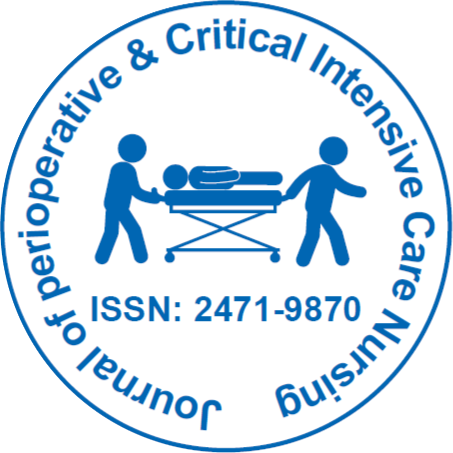
Journal of Perioperative & Critical Intensive Care Nursing
Open Access
ISSN: 2471-9870

ISSN: 2471-9870
Opinion - (2021)Volume 7, Issue 6
The Intensive Care Unit (ICU) is an exceptionally perplexing climate with cutting edge mechanical and electronic device, where complicated and obtrusive strategies are performed. Patients conceded to these units, because of specific conditions, may purposefully or unexpectedly eliminate gadgets and present a high danger of falling, which frequently prompts the need to utilize some type of insurance to guarantee their safety. Actual limitation, additionally distinguished as mechanical restriction or actual limitation, is one of the most well-known methodologies in circumstances in which the wellbeing of the basically sick patient is in danger. As indicated by the Centres for Medicare and Medicaid Services, this training is characterized as any manual strategy, physical or mechanical gadget, material or gear joined to or adjoining the patient's body that limits admittance to the body, immobilizes or decreases the patient's capacity to move arms, legs, body or head freely. Studies have broken down the various purposes behind the exercise of actual self-control in the escalated care setting, just as portrayed its rate, which goes from 0% in some European nations to more than 75% in North America. In Brazil, barely any measurable information on predominance rates in establishments was found in the writing. Notwithstanding, the inclusion of certain organizations in the country in the Magnet Journey and the advancement of patient wellbeing society have made this pointer get more consideration, which has prompted conversations and reflections on prescribed procedures comparable to the technique. There is data which affirms a higher predominance of the exercise of actual self-control inside the ICU climate (93.3%), when contrasted with the clinical center (50.9%) and the careful facility (3.8%) [1-3].
Incorporation rules for the chose articles were essential investigations that tended to the act of actual restriction in the ICU and were recorded in the chose information bases, without delimitation of study time and in English, Spanish and Portuguese. Were barred optional examinations, led with mental patients, youngsters and creatures; with subjective plan; articles, chronicles; and that were not acted in ICU. The reference utilized for the order of the degree of proof, and the factors removed from the examinations were Country, Training of experts, Year of distribution, Design, Care, Complications, Indications, and Alternative techniques identified with the act of actual limitation. Mendley programming was utilized to deal with the references.
The distribution time of the examinations happened between the years 2003 and 2018, in different nations, with a prevalence of the United States (32%), trailed by the European mainland (26%). The excess papers are dispersed among Canada, Jordan, Taiwan, China, Egypt, and South Korea. Eleven examinations (58%) have level 6 proof; two (11%), level 4; and six (31%), level 3, being generally led (84%) by medical attendants, with multidisciplinary interest of therapists, drug specialists, doctors and medical attendants.
The pursuit was directed in the data sets Latin American Caribbean Literature in Health Sciences (LILACS), Database in Nursing (BDENF), Index, Elsevier SciVerse (Scopus) and Cumulative Index Health Literature (CINAHL), and the National Library of Medicine (PubMed) gateway from September to November 2018. The data removed from the distributions was physically gone into a spread sheet ready by the analysts for this reason. The hunt scientific categorizations incorporated the descriptors "Actual Restraint", "Emergency unit", "Care Nursing", "Nursing Care", as per the Descriptors in Health Sciences (DECS) and Medical Subject Headings (MeSH); and were joined with the Boolean administrators AND (prohibitive blend), OR (added substance mix) and NOT (barring mix) in the various data sets. A broad collection of care concerning the act of actual limitation was distinguished. They are identified with patient evaluation, correspondence, and security. Among the evaluation minds, the accompanying sticks out: appraisal of the fringe perfusion of the limited appendage, of skin trustworthiness, the degree of sedation, psychomotor disturbance, level of cognizance and portability of the confined appendage [4].
Citation: Tonetti T (2021) Execution of Non-Pharmacologic Actual Limitation Minimization Mediations in the Grown-Up Emergency Unit: Perusing Survey. J Perioper Crit Intensive Care Nurs 7: 188. doi:10.35248/2471-9870.21.7.188
Received: 20-Oct-2021 Accepted: 03-Nov-2021 Published: 10-Nov-2021 , DOI: 10.35248/2471-9870.21.7.188
Copyright: © 2021 Tonetti T et al. This is an open access article distributed under the term of the Creative Commons Attribution License, which permits unrestricted use, distribution, and reproduction in any medium, provided the original work is properly cited.